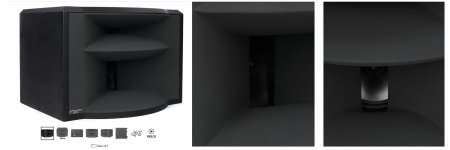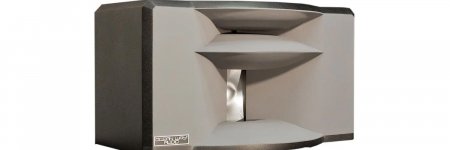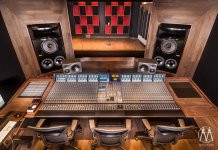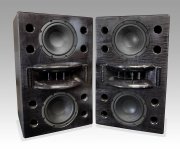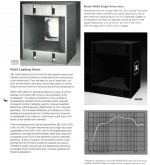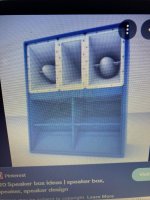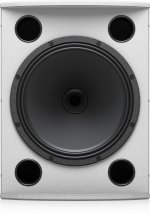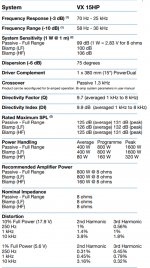acoustic suspension vs 4th order band pass...Not really because a good waveguide gives out more gently and a horn designed to load gives out all of a sudden in comparison
"I don't see it as an exaggeration but a description it sounds much more like large headphones to me much like close near field listening does." - Yes...more of this please.You've lost me as to what you mean
Sure, but you don't get as smooth transition of directivity between them unless the woofer and the waveguide/horn transition to wide polars within the same bandwidth or the transition happens sufficiently outside the crossover region for both devices to not affect the crossover region. You could use steep xo filters as well. This is where I referred earlier, I don't know how much a mismatch would matter.
Crossover at 350Hz would not get you to point source territory so I see no point why cross this low especially when the pattern control would be only to ~700Hz and you could do it there why not. If crossover was < 200Hz, pattern control to ~400Hz you'd approach point source but I'm not sure if the axis driver would be happy there. I just can't think any benefits crossing below pattern control of a horn/waveguide from the system perspective.
Of course thought experiments are not the truth especially done with not too much experience on the subject. Measurements would show how it works out and listening in situ how it sounds.
The horn is about 32" wide, So we lose pattern control around 423hz. The baffle is the same width, 15" woofer. An XO at 300hz would not render a huge mismatch. Even going from skinny to wide is not a worse case scenario. What we don't want to see is a bunch of peaks and nulls in off-axis.
Nice, it might work out just fine with so low crossover. Huge system though and the axi to the limits. I sure hope it works out! I suspect you need fairly steep crossover slopes to keep diffraction out from the woofer response and axi driver happy. Also the woofer box probably requires some work with standing waves, I hope you manage those easily but given quite long wavelengths I'm afraid it might get difficult. At least mine does have poop sound (one dimension ~32") if crossed over around above 200Hz and it is already optimized as far as I could sans CLD yet. Not sure how to address it other than making the box smaller. One could always have big baffle and small box though 😉
Last edited:
^ not my experience about the waistbending effect, but it was an octave higher around 750hz/800hz.
The outcome is an imbalance in the diffuse field which made my monitors bothering to me.
The optimal to target is what is exposed into Earl Geddes's paper about 'Directivity In Loudspeaker Systems':
some almost 'straight' polar map ( fig 8 page 8).
I don't know of many systems able to do that. I think Genelec have a sub+monitors which comes close to ( fig 9 page 8).
Second best real life achievable is a polar map which smoothly widen toward low end (fig 10 page 8).
The outcome is an imbalance in the diffuse field which made my monitors bothering to me.
The optimal to target is what is exposed into Earl Geddes's paper about 'Directivity In Loudspeaker Systems':
some almost 'straight' polar map ( fig 8 page 8).
I don't know of many systems able to do that. I think Genelec have a sub+monitors which comes close to ( fig 9 page 8).
Second best real life achievable is a polar map which smoothly widen toward low end (fig 10 page 8).
Last edited:
The other optimum being a pulsating sphere of no dimension...
Of course you can find happiness in the many possibility between this two extreme. But i think smoothness of transition on the polar map is key to smooth sound.
Of course you can find happiness in the many possibility between this two extreme. But i think smoothness of transition on the polar map is key to smooth sound.
" - I don't think this is cut and dry....I mean we put the microphone up as close as possible to a driver to get a measurement devoid of room effects....so a measurement at 6ft is going to include room in it."
Hello Camplo
Yes we do but look at what you get. The primary pulse and the reflections also after due to longer path lengths. We window to keep the reflections from messing up the measurement. The audibility of the reflections is debatable due to amplitude and time from the initial pulse. Remember with music the "pulse" never stops. So I would think amplitude would be a key factor. I am sure somewhere there is a paper on this WRT audibility reflections vs time and amplitude.
"- You are correct. I think it is the final perspective to be analyzed. Do you know how many times I've been scolded to not look at Group Delay or Decay in general, regarding bass, so intently because once its in a room, The room dominates among the frequencies its dimensions dictate it dominate. So in this case we are discussing not just areas where the room modes are but the "reflective" area? I don't know if there is a word like "Schroeder frequency", that is meant to point to the area above that term in particular, but, as I described....the polar characteristics of the loudspeaker system become even more critical, when put in a room. SPL (measurements in general) is a combination of direct and indirect energy. A loudspeaker system that maintains a more narrow directivity will generate higher Direct energy, at distance, vs one with a very wide polar. Plain to visualize and understand.... So my thought is that the more narrow the beam, the higher fidelity at listening position."
Well for sure higher SPL for a given input. It's a long throw vs short throw horn trade off. That sounds very much like Dr. Geedes idea for his Summas where he did CD with tighter pattern control to minimize room interaction. Hope I got that right.
" -Coverage angle is another word for "polar pattern" and we agree here. The wider the coverage angle, the more indirect energy is created. Regardless if the room is treated or not. Wider coverage puts more responsibility on the rooms performance, where as a more narrow coverage angle does not."
Yes and it's a personal preference in my mind. I built a pair of JBL 4344's about 20 years ago and still have them. They were old school 4 way monitors non CD and very directional in the upper octaves " tighter" than say a 4430 or M2 by quite a bit.
The 4344's are essentially head in vise where the 4430/M2 are not and both use a 100x100 or greater CD horns/waveguides. I prefer the wider pattern. Much larger sweet spot and much better and defined imaging in comparison to the 4344.
As far a polars on a 604 take a look here and there are DI charts for a Urei 813 which is a 604 copy as in 15" coax 1" CD with a helper woofer. It's DI measurements are all over the place so the polar's won't be far behind.
Improvements in Monitor Loudspeaker Systems
JBL Technical Notes Volume 1 Number 15
Rob🙂
Hello Camplo
Yes we do but look at what you get. The primary pulse and the reflections also after due to longer path lengths. We window to keep the reflections from messing up the measurement. The audibility of the reflections is debatable due to amplitude and time from the initial pulse. Remember with music the "pulse" never stops. So I would think amplitude would be a key factor. I am sure somewhere there is a paper on this WRT audibility reflections vs time and amplitude.
"- You are correct. I think it is the final perspective to be analyzed. Do you know how many times I've been scolded to not look at Group Delay or Decay in general, regarding bass, so intently because once its in a room, The room dominates among the frequencies its dimensions dictate it dominate. So in this case we are discussing not just areas where the room modes are but the "reflective" area? I don't know if there is a word like "Schroeder frequency", that is meant to point to the area above that term in particular, but, as I described....the polar characteristics of the loudspeaker system become even more critical, when put in a room. SPL (measurements in general) is a combination of direct and indirect energy. A loudspeaker system that maintains a more narrow directivity will generate higher Direct energy, at distance, vs one with a very wide polar. Plain to visualize and understand.... So my thought is that the more narrow the beam, the higher fidelity at listening position."
Well for sure higher SPL for a given input. It's a long throw vs short throw horn trade off. That sounds very much like Dr. Geedes idea for his Summas where he did CD with tighter pattern control to minimize room interaction. Hope I got that right.
" -Coverage angle is another word for "polar pattern" and we agree here. The wider the coverage angle, the more indirect energy is created. Regardless if the room is treated or not. Wider coverage puts more responsibility on the rooms performance, where as a more narrow coverage angle does not."
Yes and it's a personal preference in my mind. I built a pair of JBL 4344's about 20 years ago and still have them. They were old school 4 way monitors non CD and very directional in the upper octaves " tighter" than say a 4430 or M2 by quite a bit.
The 4344's are essentially head in vise where the 4430/M2 are not and both use a 100x100 or greater CD horns/waveguides. I prefer the wider pattern. Much larger sweet spot and much better and defined imaging in comparison to the 4344.
As far a polars on a 604 take a look here and there are DI charts for a Urei 813 which is a 604 copy as in 15" coax 1" CD with a helper woofer. It's DI measurements are all over the place so the polar's won't be far behind.
Improvements in Monitor Loudspeaker Systems
JBL Technical Notes Volume 1 Number 15
Rob🙂
Last edited:
The other optimum being a pulsating sphere of no dimension...
Of course you can find happiness in the many possibility between this two extreme. But i think smoothness of transition on the polar map is key to smooth sound.
Hello krivium
I agree on that. That's been my experience as well
Rob 🙂
I think this touches on the differences between the ideal "pro" dispersion characteristics and the dispersion characteristics that are more desirable in home "hifi" applications. Like you Rob, I prefer a bit wider dispersion at home. Horn designs intended for home use should focus on this aspect a bit more.Yes and it's a personal preference in my mind. I built a pair of JBL 4344's about 20 years ago and still have them. They were old school 4 way monitors non CD and very directional in the upper octaves " tighter" than say a 4430 or M2 by quite a bit.
The 4344's are essentially head in vise where the 4430/M2 are not and both use a 100x100 or greater CD horns/waveguides. I prefer the wider pattern. Much larger sweet spot and much better and defined imaging in comparison to the 4344.
Rob🙂
Last edited:
Anyone have an actual polar map of an Altec 604?
On a thought train...
You would think the slot caused some type of ill affect on the woofer here?
604-8K with the [then] superior Mantaray diffraction horn: 604-8K
?? You mean the horn's throat? Why? There's no parallel sides and it's a 1:1 CR.
The 816, 817, 210 horns with parallel sides is a whole different matter though when compared to the 825/828: http://www.lansingheritage.org/images/altec/specs/components/515g/page3.jpg
GM - I was referring to the way the sides of the slot overlap the woofer cone....theres a bit of area on each side of the woofer that is covered by....the slot. That, has no negative effect on SQ? Just a mere change in dispersion? There should be distortion at the edge of the those surfaces, shouldn't there?
Attachments
Last edited:
This construction with the partial coverage leads to some compression like it is used in compression drivers. Although with a much smaller ratio. But the throat shape of the VOTT isn't very smooth which will have some negative effects. A similar construction with a much smoother shape was once made by RCF. The same RCF horn shape is still used for the larger Ocean Way monitors.
Regards
Charles
Regards
Charles
This:
EON615 JBL woofer directivity control waveguide | Audio Science Review (ASR) Forum
might be of interest
EON615 JBL woofer directivity control waveguide | Audio Science Review (ASR) Forum
might be of interest
Not really, the horn only loads to ~338 Hz and the only real anomaly in its frequency response is due to the XO in the 400-500 Hz BW. The slight 'ripple' is due to the truncated mouth; add its original baffle to make it 50" wide x 67" high and it's nominally ripple free, flat down to ~66 Hz: 800 VOTT
is still used for the larger Ocean Way monitors.
Regards
Charles
so not this then?
Maybe like this?
TAD would be proud
Attachments
Last edited:
....theres a bit of area on each side of the woofer that is covered by....the slot.
1)That, has no negative effect on SQ?
2) Just a mere change in dispersion?
3)There should be distortion at the edge of the those surfaces, shouldn't there?
1)When using drivers capable of wide overlap in the crossover region, in most cases reducing the frequency bandwidth required from the HF driver in it's lower frequency range, and covering a bit higher with the woofer (or low mid) improves sound quality. The "pioneers" of horn speaker development recognized that around a decade of operation was the limit for really good sound quality from horn/driver combinations, which has ultimately resulted in most HF drivers now being used above 1000 Hz if they are required to cover the extent of HF hearing.
2) The Ocean Way monitor uses a more narrow slot to match the wider dispersion of it's HF horn crossed over at a higher frequency than the 1950's era RCA model MI-9462 radial mid-bass theater horn it's design is based on.
"Mere" matching of LF to HF horizontal dispersion in the 500-1500 range where slotted woofers typically cross over to a HF horn is considered quite important to most critical listeners.
3) Covering the outer portions of the woofer creases an acoustical low-pass filter, which reduces both the upper range and harmonic distortion components.
The JBL 4560 is typical of short exponential type mid-bass horns, it's frequency response illustrates +5dB horn gain in the 200-700 Hz region followed by the acoustical LP reduction of around 8dB, dropping to a few dB lower than a front-loaded speaker's response in the 1kHz range.
Attachments
The waveguide on the midwoofers here, whats the science behind this? A live sound guy tells me that these loaded with smaller woofers are replacing 15" mids...claimed that smaller woofer had better transient response, due to lighter cone, and the bullet thing in the middle was not exactly a phase plug but provided front pressure and helped balance the diaphragm with the pressure behind the woofer via cab....
I know some of thats mot true lol
Attachments
That phase-plug had (and HAS on newer designs) exactly the same function like the phase-plug of a compression driver.
Regards
Charles
Regards
Charles
This might be of interest as well.
Rob 🙂
https://jblpro.com/en/site_elements/tech-note-cone-midrange-compression-drivers-cmcd
Rob 🙂
https://jblpro.com/en/site_elements/tech-note-cone-midrange-compression-drivers-cmcd
Both waveguides and horns can be designed to be better than the examples you show. Docali has some great horns and mabat has some great waveguides.
"Better"
So in efforts to stay entertained, I've started brain storming devils advocates to solution of the goal I had here. I have everything I need to entertain horns and waveguides, but I have not lost sight of one of the original ideas of this thread, a FAST/WAW type speaker....Using the knowledge I've picked up in this thread, and applying it to the idea of using a Coaxial top, results in an interesting amount of sd.


A driver like this, in an MTM configuration with pair of 15s or 18s. I noticed that with the Kingdom model the Tweeter is being crossed at 700hz... Its likely that the same potential is true for the Tweeter in the VX line. From there one would cross over to the low woofer at what?....... high to low order XO could be used...several different ways to keep excursion from the Middle mid....
Sensitivity is high for both the tweeter and mid woofer of the Tannoy vx15
Has anyone seen or heard anything like this? The SD in the crossband of the 3 woofers would be very large in accumulation. I could see this pairing well with the Pairs o 18h+'s I have. Not a 2 way technically, but retaining the limit of 2 axis, that a 2 way has.
A driver like this, in an MTM configuration with pair of 15s or 18s. I noticed that with the Kingdom model the Tweeter is being crossed at 700hz... Its likely that the same potential is true for the Tweeter in the VX line. From there one would cross over to the low woofer at what?....... high to low order XO could be used...several different ways to keep excursion from the Middle mid....
Sensitivity is high for both the tweeter and mid woofer of the Tannoy vx15
Has anyone seen or heard anything like this? The SD in the crossband of the 3 woofers would be very large in accumulation. I could see this pairing well with the Pairs o 18h+'s I have. Not a 2 way technically, but retaining the limit of 2 axis, that a 2 way has.
Attachments
Last edited:
- Home
- Loudspeakers
- Multi-Way
- Is it possible to cover the whole spectrum, high SPL, low distortion with a 2-way?

